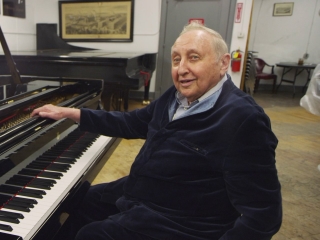As I grappled with matters of tempo, mood, and interpretation in learning a Baroque era work, I found a kindred spirit in Seymour Bernstein who openly shared his introspective thoughts about re-thinking a well-known composition in the piano literature.
Encapsulated in an e-mailed communication to his league of followers, Bernstein addresses the common temptation among musicians to check recordings of other pianists to validate personal and individualized interpretative choices. His words are sobering and candid as he explains how he has come to choose a “new” pace and affective interweaving of emotions through various sections of the Schumann Arabesque, Op. 18. His enlightening revisit is a tribute to his evolving understanding of music that has grown by steady increments over decades. It suggests a creative point of departure from which we can derive great benefit.

***
Dear friends,
“Schumann’s Arabesque is among the romantic works that elicit a wide variation of interpretations. I, personally, don’t like to listen to performances of the pieces I study. I prefer to come to my own conclusions, and then listen out of curiosity to see how other pianists interpret the compositions I am working on. In terms of tempo, Arthur Rubinstein and I are the only pianists I have heard who take the opening theme of Arabesque leisurely. Everyone else races through it with breathless intensity, even though the English translation of Schumann’s indication is “light and tender.” More curious is that most pianists play sections B and C faster in contradiction to Schumann’s “etwas langsameer” (“somewhat slower”). I’m no exception. I confess that I did the same in my first performance of this work on You Tube, which I now will remove.
“Perhaps it’s the age of 90 that has inspired me to probe this work with far greater introspection than I have in the past. Now that I know that most “hairpins” in romantic music mean rubato, and not cresc. and dim. I take more time whenever they appear. Moreover, I like to play the coda, Zum Shloss, Langsamer (“slowly”) as Schumann indicated.
“Finally, the question is “How fast is fast, and how slow is slow?” It is the human condition to respond as we see fit. There are no rules concerning tempo, even though composers often leave Metronome markings. But through the years, composers have come to place the word circa, meaning around, or approximately, before the Metronome number. Beethoven said it all when Schindler asked him “Master, how fast is this Allegro?” Beethoven’s response must have amazed Schindler: “Allegro doesn’t mean fast,” Beethoven replied; “It means “merry.” The lesson we learn from this is that tempo indications are feelings, and not simply mathematical equations. Because we all think that the composers whisper their secrets in our ear, it is small wonder that there is an interpretation for all seasons.”
Seymour
from Arioso7's Blog (Shirley Kirsten)
https://arioso7.wordpress.com/2017/08/30/pianist-seymour-bernstein-revisits-the-schumann-arabesque-at-the-age-of-90/
No comments:
Post a Comment